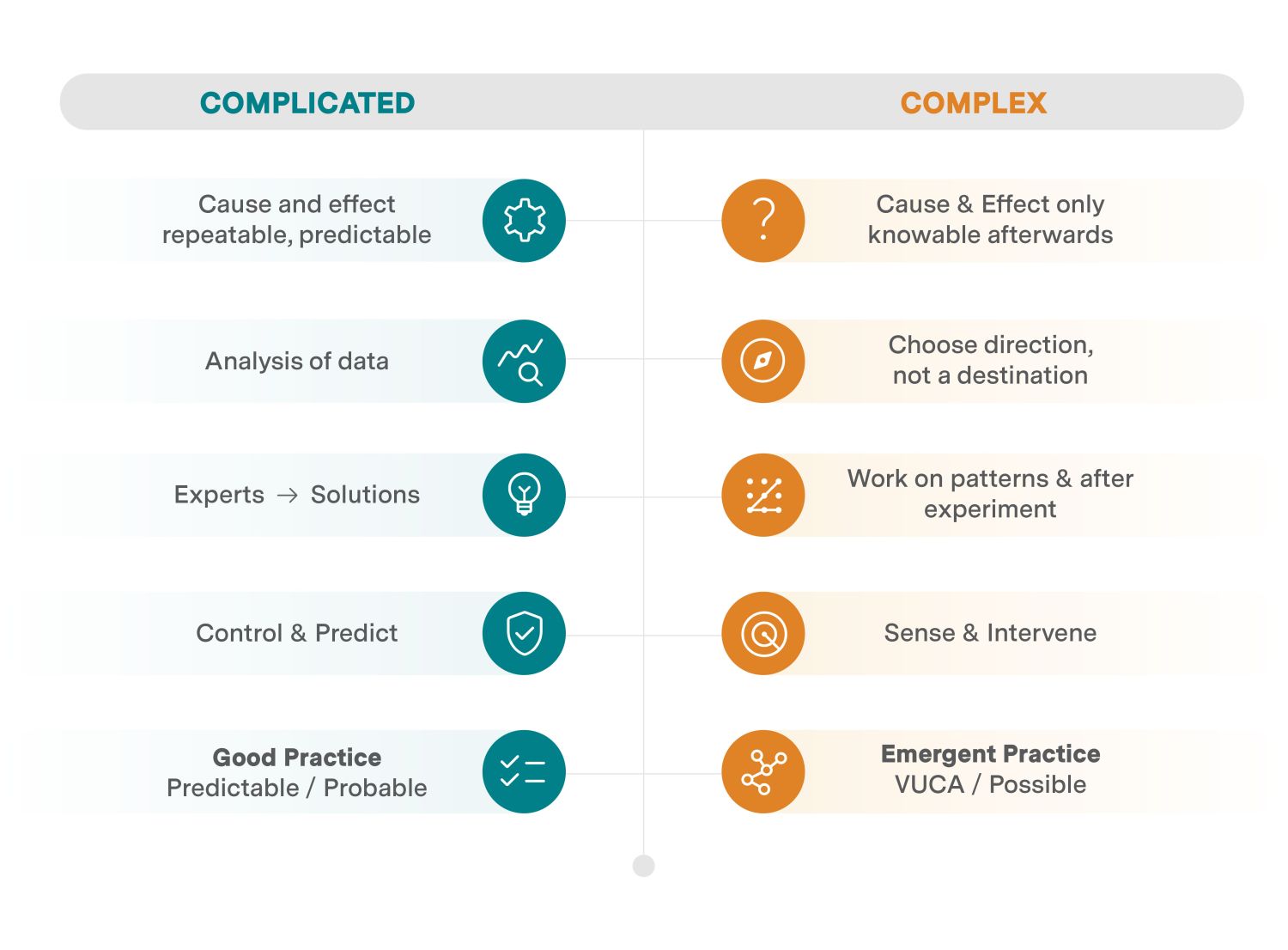There has never been a more exciting time in history to work in Human Resources than now. The more I talk to Chief People Officers, Heads of Talent, Divisional HR Heads and other HR Leaders, the more I feel they are being called to do more, contribute more, and to step up.
I recently spoke to 100 HR leaders from a global company about why this moment is so pivotal—and why the function needs to evolve as the environment changes. What follows are key insights.
Three Major Trends Impacting the HR Function
When we at Egon Zehnder, together with our partners at Mobius, run our executive development programs, we often establish on day one of those retreats that "business leadership today takes place in the realm of a Complex (vs. Complicated) world." We use an extract from the Cynefin® framework to explain the distinction between those two realities (see figure below).
For example, while building a rocket and flying it to the moon is actually "only" a (very) Complicated task that can be accomplished if the needed resources and expertise are available, making human-related decisions in organizations often falls into the Complex category. Consider typical HR challenges such as driving a culture of performance and care, or increasing employee engagement, or yet setting up the “right” hybrid work policy. In all these cases, multiple options are available, many things can be simultaneously valid and true, and the way to find a solution often requires more than just having expertise and resources in the room.
The need to navigate such complexity, where simply having good HR processes and policies is not enough, is one accelerated trend impacting the HR function in the post-COVID era.

While this second macro trend is not necessarily new, it is accelerating exponentially with the development of artificial intelligence and its presence in the workplace. Managed effectively, technology can significantly augment the impact an HR organization can have on any given company. HR leaders I converse with often describe three ways AI is rapidly integrating into their world:
- Automation of back-end HR processes, such as employee self-services powered by known HRIS platforms;
-
Use of data and analytics to support and improve HR decisions such as hiring, nomination to succession pipelines, promotions, and pay; -
Talent acquisition as the interface between organizations and external talent pools has received enormous technological investment in the last years—resulting in many tech-powered recruiting solutions which enhance the speed and effectiveness of hiring processes managed by HR.
The third macro trend encompasses many elements that impact how we relate to work in general and how employees' expectations toward their employers have changed—particularly over the last years. Topics like work-life integration, mental health, Diversity, Equity & Inclusion, multi-generational workforce, new ways of working and organizational culture are some of the key parts of this cluster, which continues to stretch the scope of the HR function in any organization.
Implications for HR Leaders
Effectively leading the People function in organizations across industries today calls for adaptation. As trends keep unfolding, there five key areas for HR leaders to stretch into and keep up with the increasing demands on them:
- Ability to navigate dilemmas and manage polarities. As complexity increases in organizations, HR leaders will increasingly face decisions that cannot be solved by processes or policies alone. Rather, these will require sophisticated thinking, asking better questions, facilitating diverse gatherings, and bringing more voices to the table. Coaching and dialogue facilitation skills become crucial for HR leaders in this new reality.
-
Fluency in data and technology. As AI becomes more prevalent in HR, knowing how to use data to substantiate discussions will set great HR leaders apart from the rest. Therefore, leveraging technology to meet increasing job demands will be a crucial skill for every HR professional. -
Exercising curiosity. Constantly learning new ways to perform our jobs is the new normal. This requires active curiosity to explore new technologies and delve deeper into significant topics. HR executives need to be able to hold more than just a superficial dialogue in areas like DEI, organizational culture and mental health, for example, to drive change and support business leaders in their companies. -
Showing courage. HR leaders are often seen as the "Chief Emotional Officers" or "Chief Relationship Officers" in their organizations. While showing care and humanity is essential, in today's complex and ambivalent world, guarding values and reminding leaders of their moral compasses has never been as important. In the face of the upgraded mission of the HR function in organizations, HR leaders must therefore show courage by speaking up to toxic behaviors, ensuring organizations stay true to their purpose, and by calling out inconsistencies between discourse and actions. -
Knowing yourself and prioritizing self-development. Anecdotal evidence suggests the HR function receives the smallest share of any organization's Learning and Development budget. HR leaders may often feel shy, embarrassed, or not authorized to participate in development programs curated and promoted by themselves. While part of this stems from the very noble and selfless nature of the HR vocation, this needs to change. With increased demands on HR leaders, their development is crucial in terms of leadership, functional, and business-related skills.
As some colleagues and I stated in another article a couple of years ago, titled Transform Yourself to Transform Human Resources, HR leaders need to "put the oxygen mask first" and work on their own personal transformation in order to support the transformation in the organizations they support.
As the title of this article suggests, I genuinely believe there has never been a more exciting time than now to work in Human Resources. The function has earned its seat at the C-level table, the call to action is clear, and the opportunity is there. Now it’s up to each HR leader to rise to the challenge and use that window of opportunity to create real impact.





